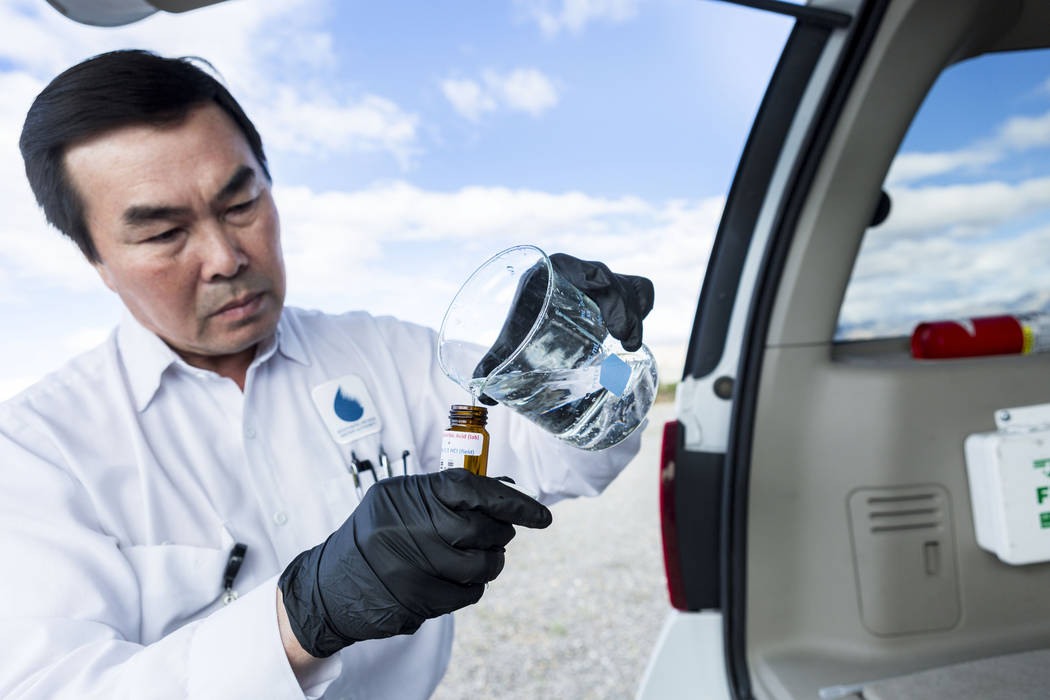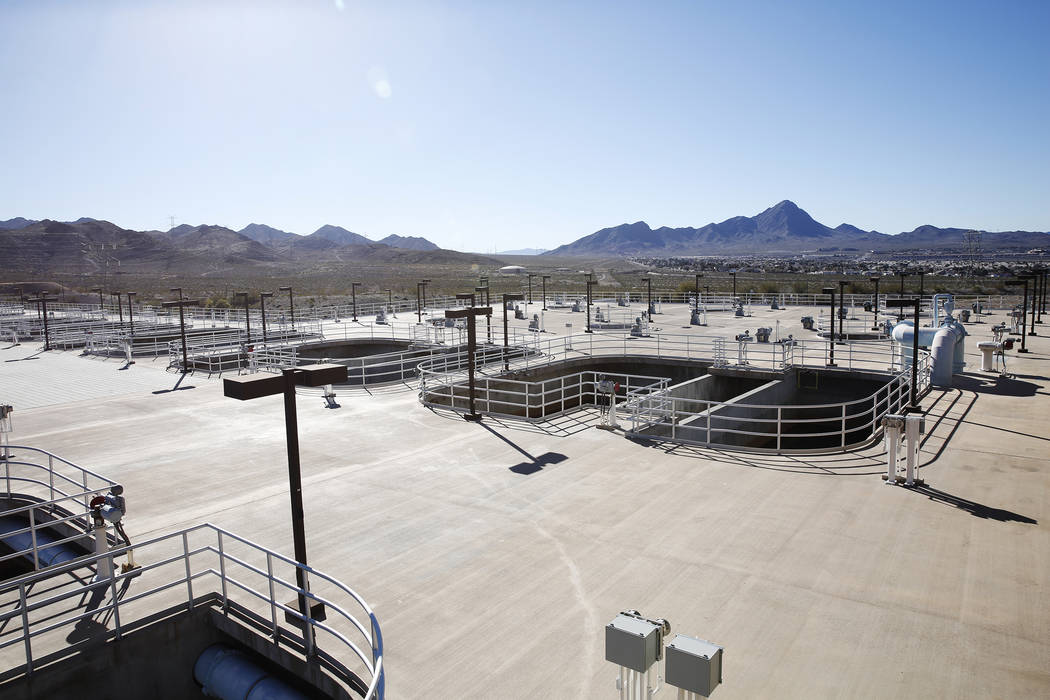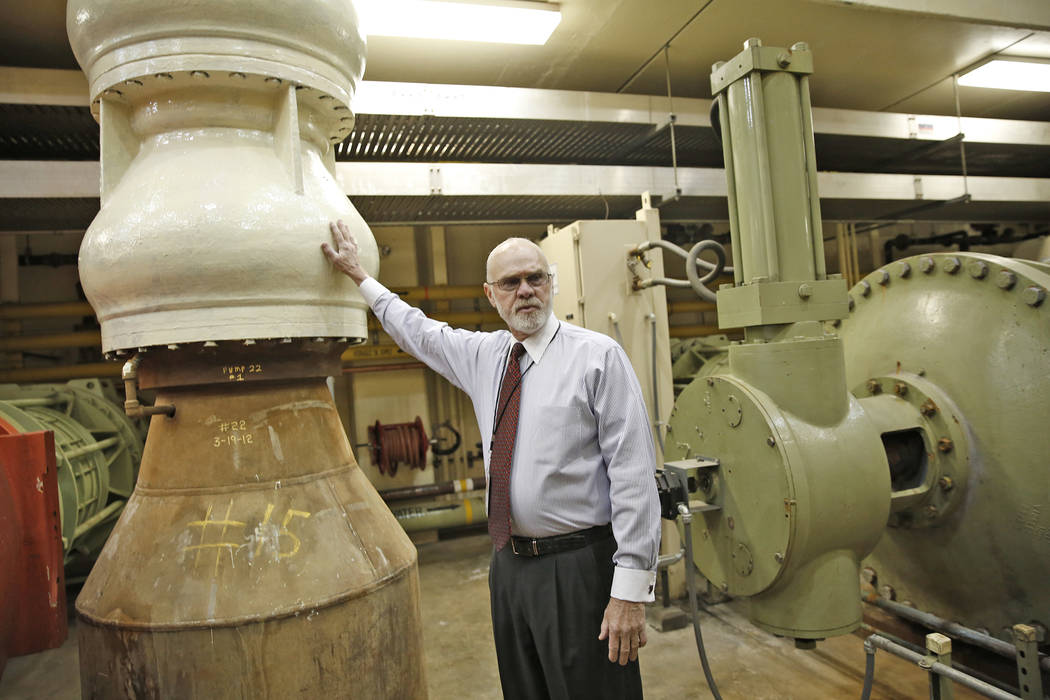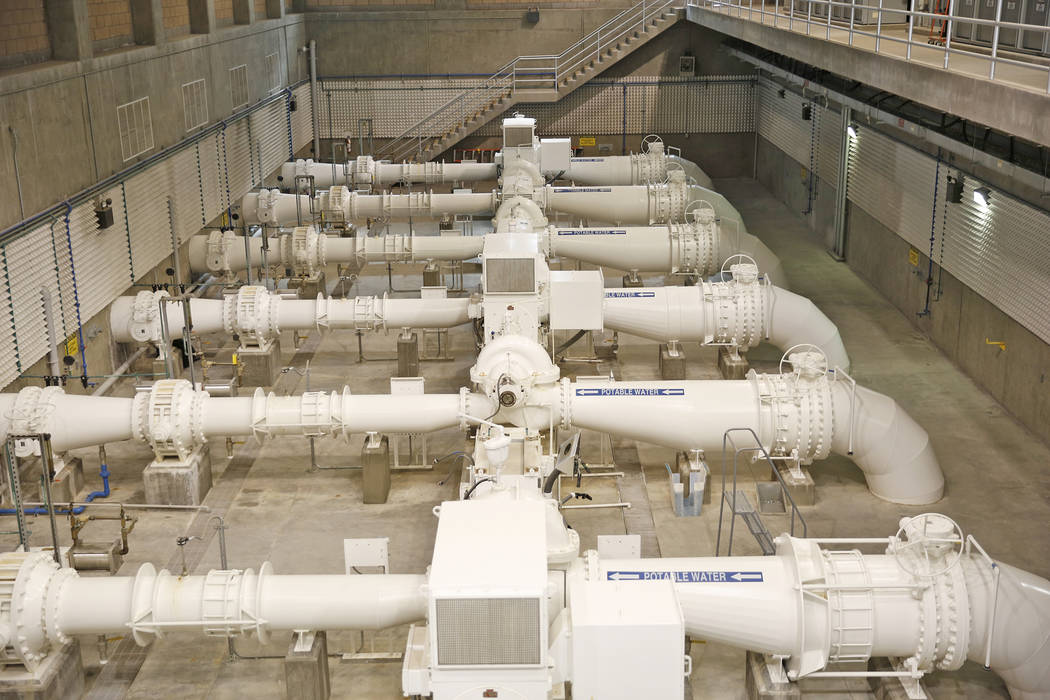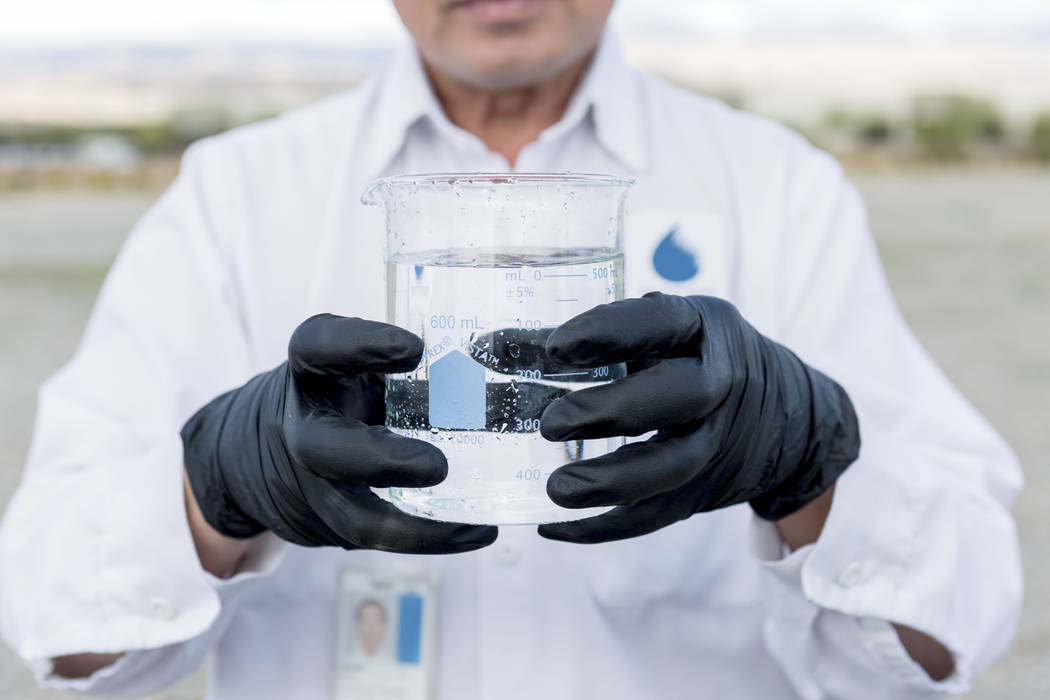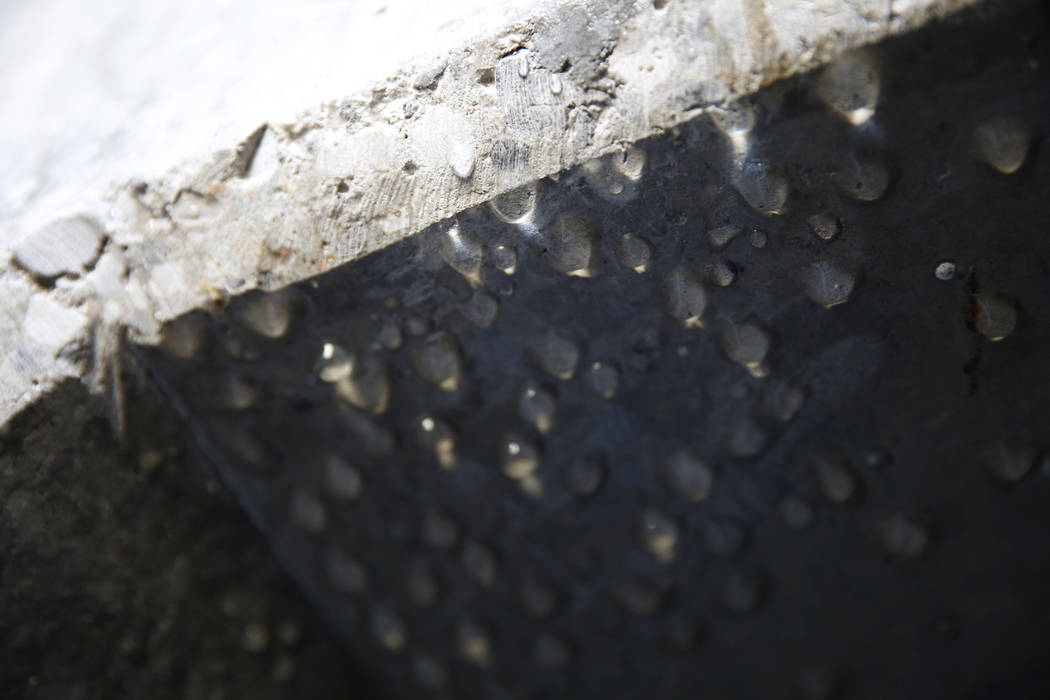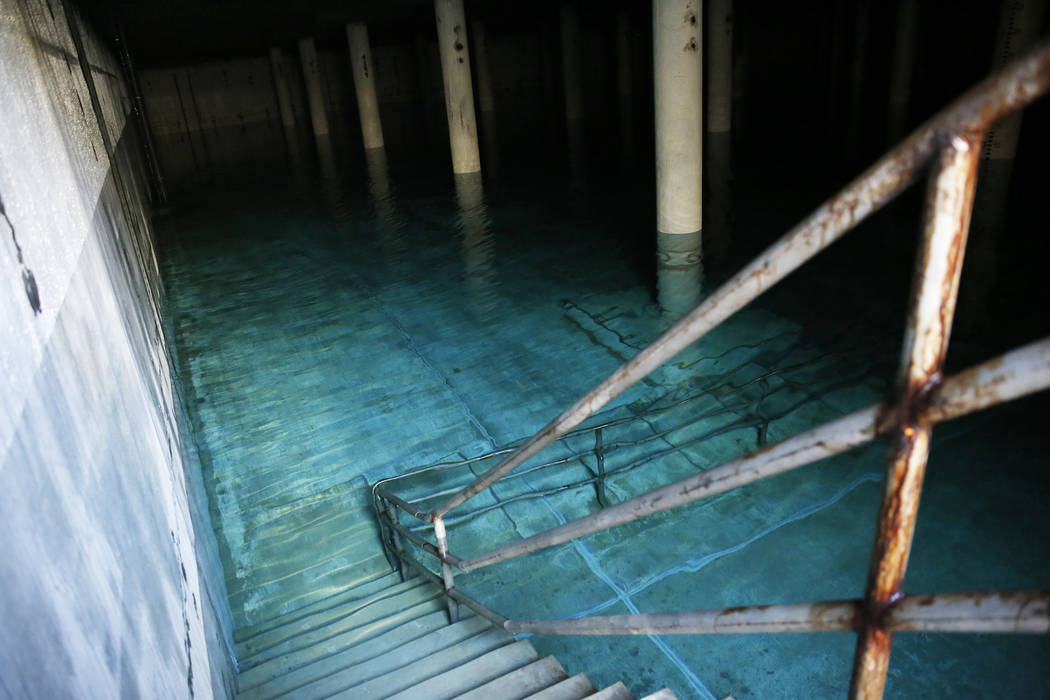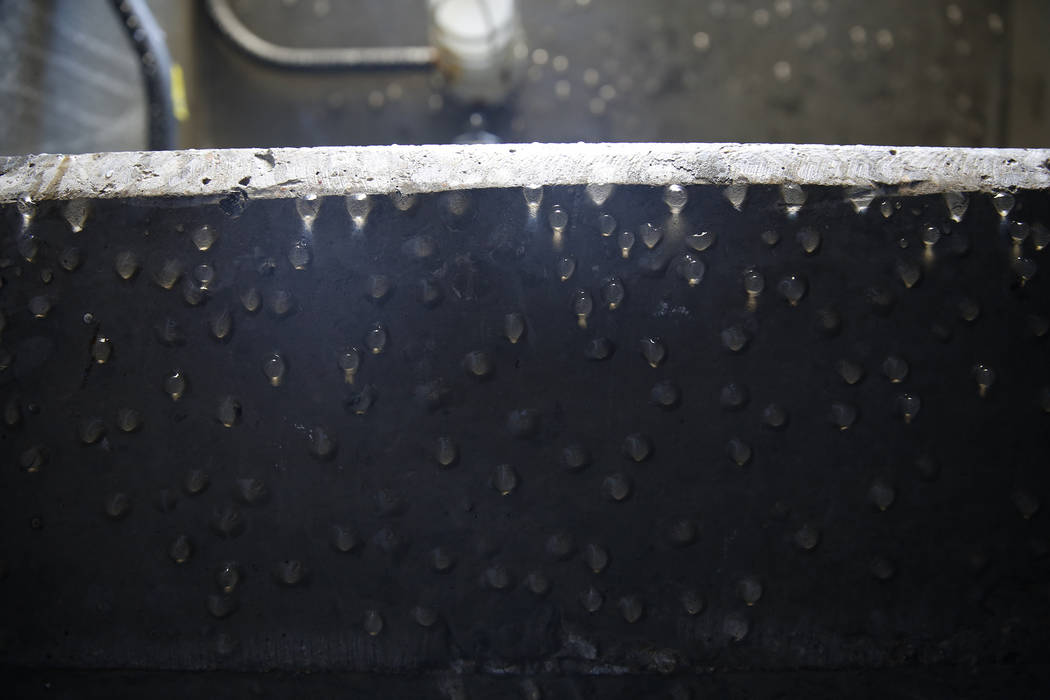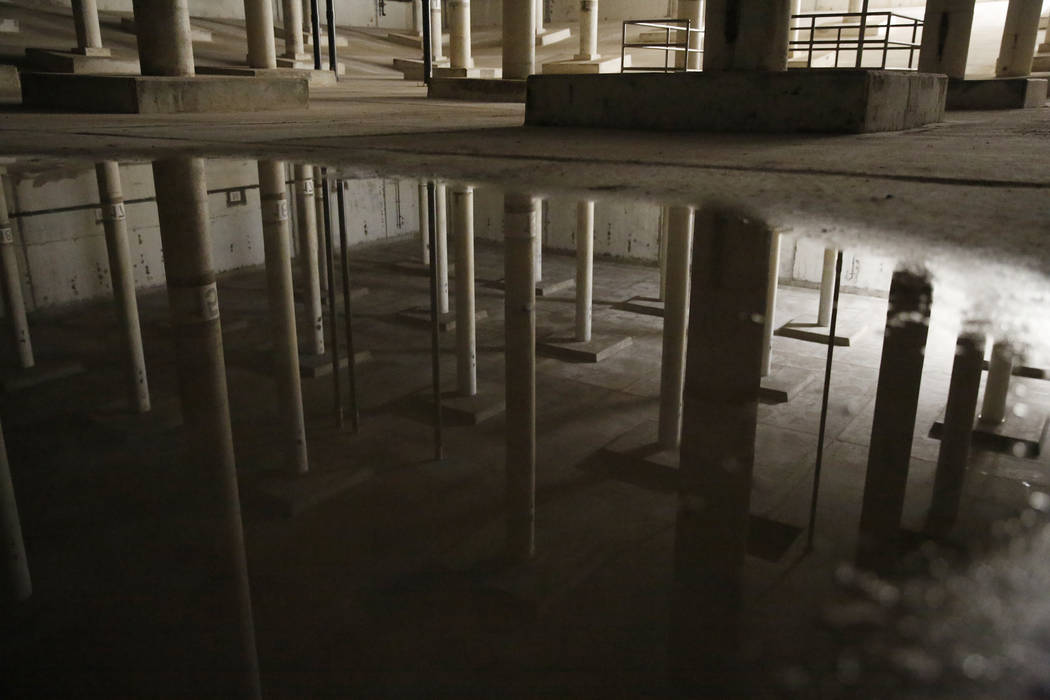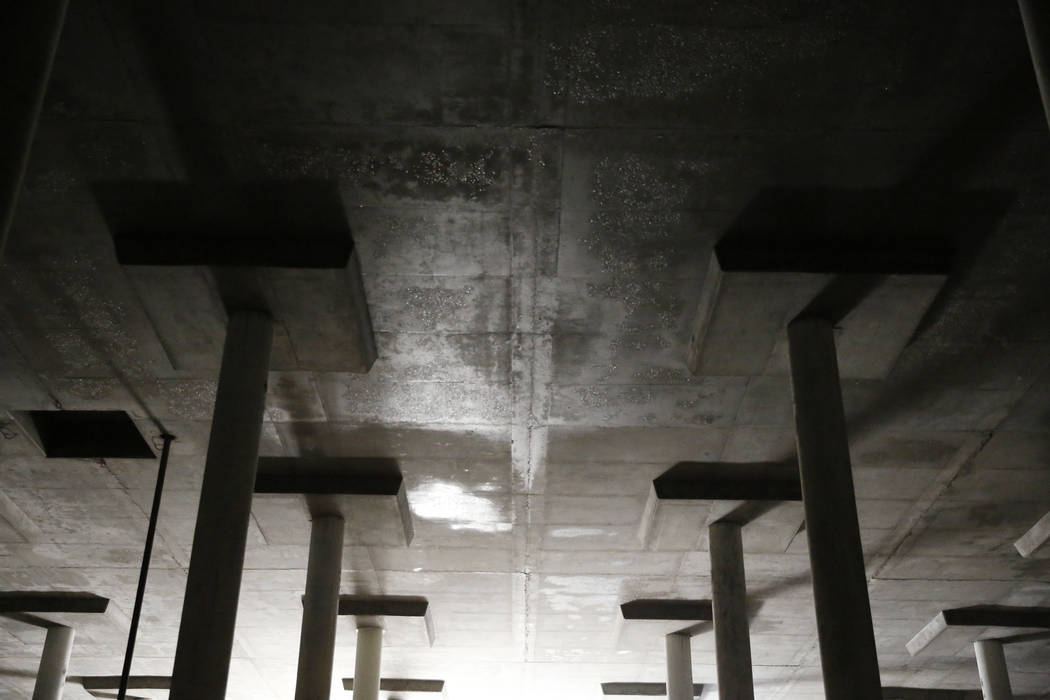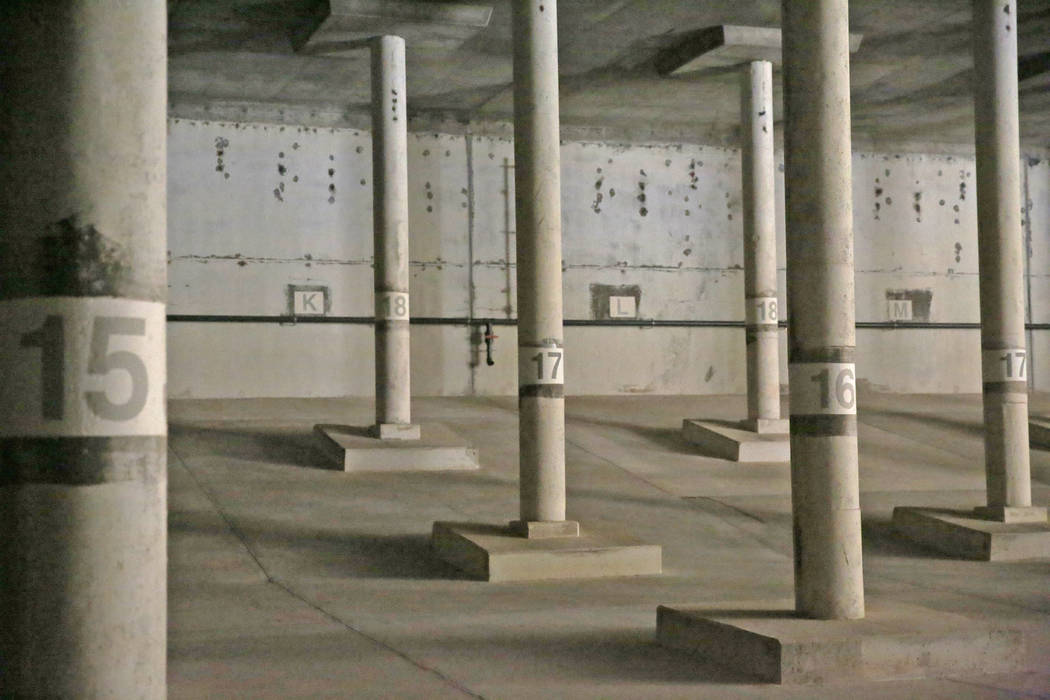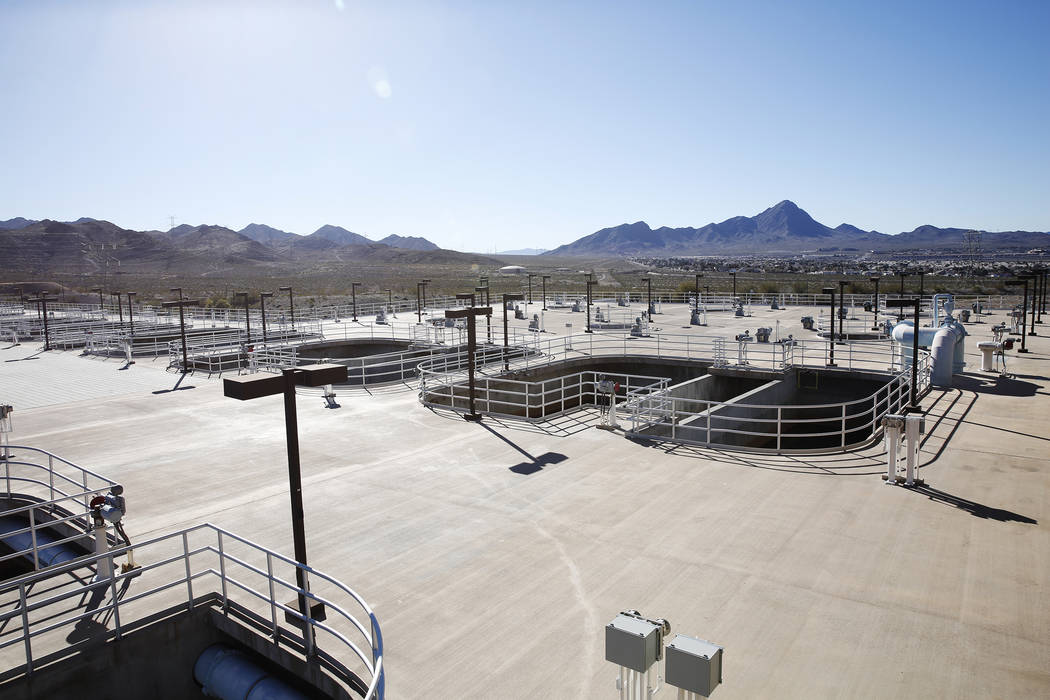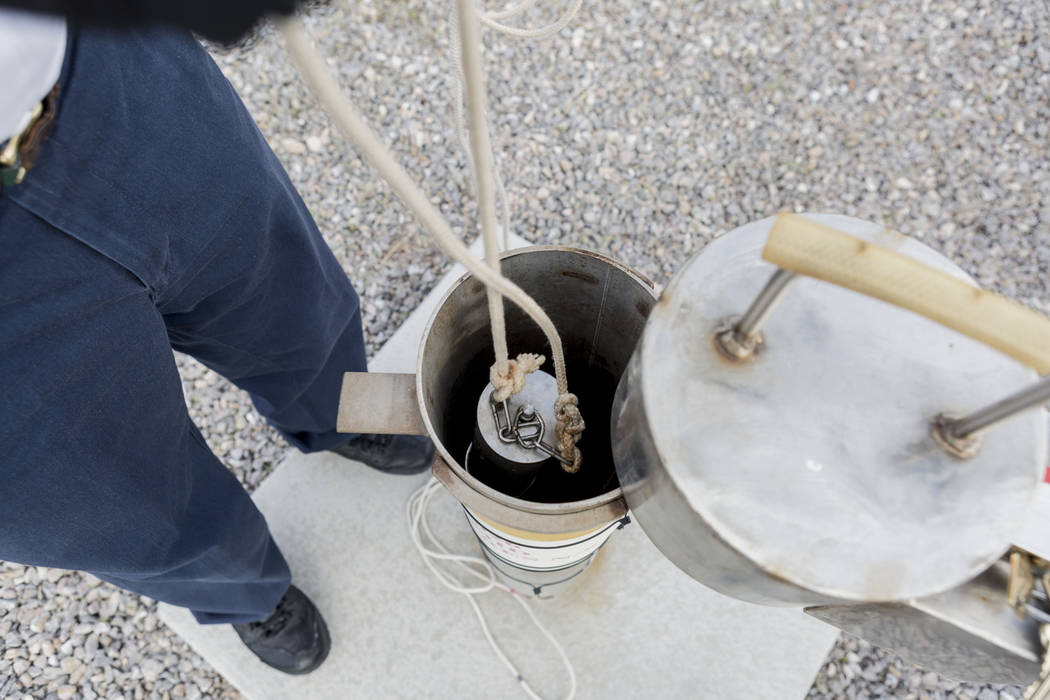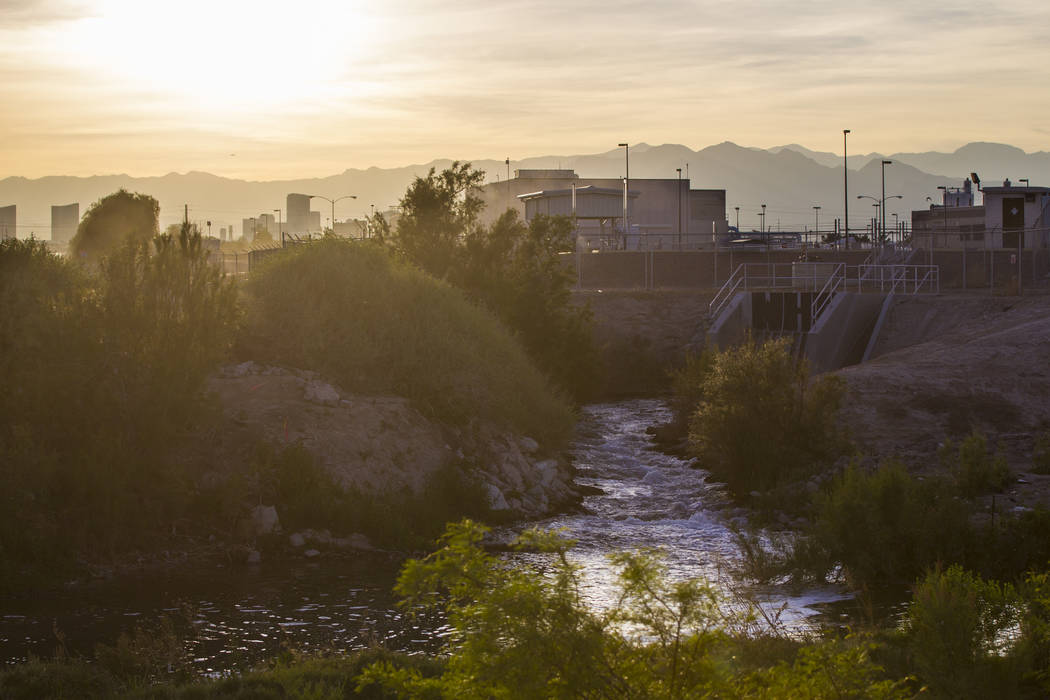Follow a gallon of water from Lake Mead to a Las Vegas tap
Water trickles from a job site and gathers along the curb to evaporate in a new gated neighborhood under construction at the Las Vegas Valley’s western edge.
There is barely enough liquid running down this Far Hills street to wash a load of laundry, but it’s hard not to feel its loss when you consider how far it came.
To reach this Summerlin neighborhood at the farthest reaches of the valley’s distribution network, water must travel more than 50 miles by pipe and climb more than 2,500 vertical feet, a height greater than two Stratosphere Towers stacked on top of each other.
Depending on the time of year, the trip can take as much as 10 days.
So long as faucets run and toilets flush, most valley residents don’t give much thought to how their water gets to them. The average tourist on the Strip probably thinks about it even less. But getting water from the source to the tap requires a lot of infrastructure, energy and engineering.
Join us as we follow a single gallon on its long and complicated voyage from supply to demand.
Up from the depths
The journey begins at a secure site near the southwestern shore of Lake Mead, where a Southern Nevada Water Authority building thrums with more horsepower than the Indy 500.
Completed in 2002 to satisfy the valley’s growing thirst, Intake Pump Station No. 2 draws lake water through a 20-foot-wide “straw” that pokes up from the bottom of the reservoir three miles from shore.
The water is lifted 275 feet from the intake to the land by 22 vertical pumps, each about 20 feet tall and ranging in strength from 3,000 to 4,600 horsepower.
“So they can make your car go really, really fast,” jokes Mark Walters, production manager for the authority, the region’s wholesale water supplier. “It’s impressive when you’re standing beneath these behemoths.”
The pumps are powerful because they have to be. A single gallon of water weighs about 8 pounds, and this facility is called on to lift about 600 million of them on an average day.
The station, one of two relied on to pump 90 percent of the valley’s water supply, is hooked to two separate electrical transformers, in case one of them fails or needs to be taken out of service for maintenance.
“We probably have the highest power bill in the valley,” Walters says. “Water is heavy, and we have to lift it a long way.”
It costs about $4,000 a day for the power needed to run a single pump. All told, the water authority spends about $38 million a year on electricity.
Running full blast, the pump station can pull up to 720 million gallons of water a day from Lake Mead and send it uphill through two booster pumping stations to the authority-run River Mountains Water Treatment Plant in Henderson, roughly 11 miles away and 1,000 feet higher than the lake.
The pumps that do the work are custom-made for the authority, Walters says, adding that “you can’t go to Lowe’s and pick one up.”
He doesn’t know of another pump station on Earth where vertical pumps this powerful are being put to work like this every day.
“This is probably one of the only facilities where pumps of this size are pumping this volume of water,” Walters says.
For now, anyway.
The water authority is building a new pumping station capable of drawing up to 900 million gallons per day from the bottom of Lake Mead even if the surface of the reservoir drops another 86 feet and leaves IPS1 and IPS2 sucking air. That $650 million effort to protect the community’s water supply is slated for completion in 2020.
Treatment before travel
Kevin Fisher knows the work he does often gets taken for granted, but he doesn’t mind. The director of water quality and treatment for the authority says he considers it proof that the system is working as advertised.
“It’s a funny thing: People turn the faucet on and they want water to come out,” Fisher says from the windowed control center overlooking the River Mountains Water Treatment Plant.
At least one operator staffs this room around the clock, tracking in real time as raw lake water flows into the facility and its sister plant closer to Lake Mead to be cleaned and distributed across the valley.
Our still-untreated gallon arrives at River Mountains by way of a tunnel punched through the mountains between Henderson and the lake. Its first stop in the treatment process is the ozone chamber, where the water is bombarded with bubbles of the unstable molecule to break up any microscopic organisms or other biological material.
Fisher says the plant produces ozone by exposing oxygen to high-voltage electricity “at a very high frequency.” From an observation window — built before 9/11, when the authority envisioned regular public tours of the facility — you can see and hear the ozone being zapped into existence.
River Mountains also produces its own oxygen so the authority doesn’t have to buy and store tanks of the liquid stuff, Fisher says.
Tractor-trailers filled with salt are brought in to make sodium hypochlorite, more commonly known as bleach, for disinfection. The plant goes through 60 to 80 tons of “almost table grade” salt every week, Fisher says.
Fresh from the ozone chamber, our gallon is blasted with the disinfectant and a coagulant on its way to the final step: a multistage filtration process that causes small particles to collect at the surface before the water is filtered through five feet of anthracite coal and another foot of sand.
Our gallon’s trip from Lake Mead through the treatment plant takes about 4 hours.
A pipe carries the finished product to three basins known as clear wells to await distribution. Approximately 75 million gallons of treated water can be stored at River Mountains. To “maximize water quality and minimize water age,” workers try not to keep it there for more than a day, Fisher says.
Climbing the stairs
Water flows from the authority to its member utilities through massive underground transmission pipes — or laterals — that branch out across the valley from the two treatment plants.
Our gallon begins its westward journey inside a pipe up to 9 feet wide known as the South Valley Lateral, which skirts the southern edge of Henderson and crosses beneath Interstate 15 before dead-ending at a reservoir and pumping station near Warm Springs Road and Jones Boulevard.
This is where the Las Vegas Valley Water District takes custody of our gallon and millions of others like it every day.
From here, the utility will use gravity to feed the water to its customers below or pump it farther uphill to other links in a chain that includes some 6,500 miles of pipelines and dozens of water tanks and buried reservoirs. 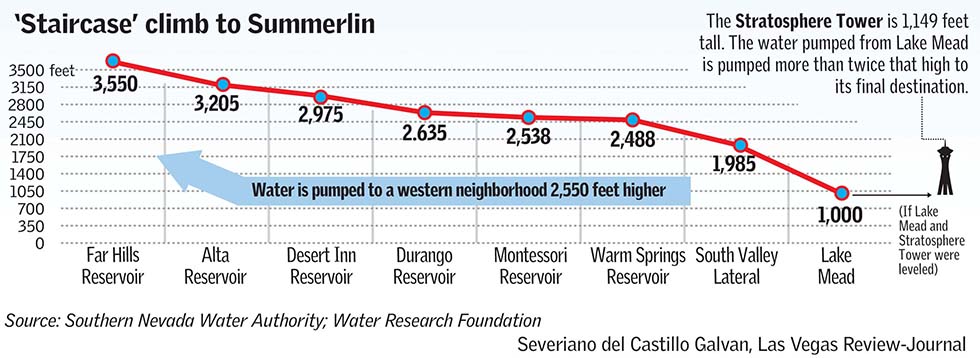
Picture the community as a long staircase with the east valley at the bottom, Summerlin at the top and a reservoir and pump station on each landing. The reservoirs serve the homes and businesses on the stairs below them, and the pump stations send water up to the landings above.
Operations Superintendent Janelle Boelter watches it all unfold from the district’s 24-hour command center at its headquarters on Valley View Boulevard.
There technicians use computer terminals and a wall of display screens to track reservoir capacity, operate pumps and valves, monitor water quality, respond to alarms and reroute water in the event of an emergency or scheduled repair.
Fortunately, Boelter says, “we have a lot of different options for moving water around. It helps me sleep at night.”
Boelter and her staff are also called on to see into the future, using demand projections and historical data to anticipate where water will be needed in the days and weeks to come.
“It’s different on Monday than it is on Friday. It’s different in January than it is in July, obviously,” she says of water demand. “We’ve been doing this day in and day out for years and years, so we’ve gotten pretty good at it.”
Across town at 3 mph
Stephen Anderson, production manager for the district, says water travels through the system at an average velocity of 5 to 7 feet per second, or roughly 3 to 5 mph.
The goal is to keep it moving and get it to where it needs to go as quickly and efficiently as possible, mainly to limit cost. The longer water lingers in the pipes before it is delivered, the more chlorine that has to be added along the way to keep it clean.
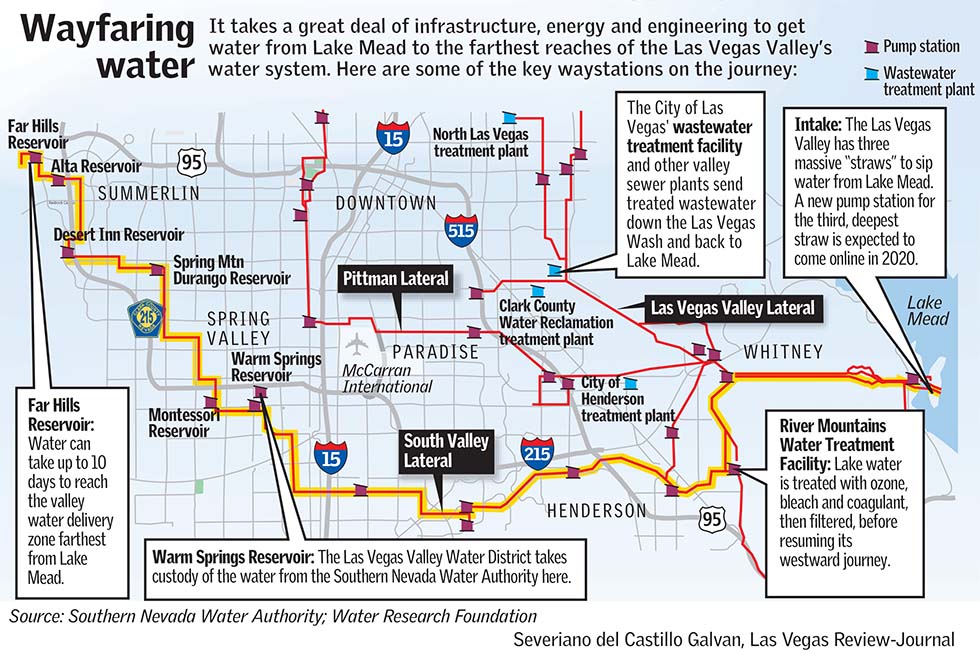
Click for a larger map.
“The faster we can move the water, the better our water quality will remain,” Anderson says.
Far Hills is the highest reservoir in the district’s system, at least for the moment. To reach it from Warm Springs, our gallon must climb another 1,000 feet through numerous other “pressure zones,” pausing in four different reservoirs along the way for a booster shot of chlorine and perhaps a spot check by a water sampling technician.
Anderson says the entire trip, from the lake to the end of the line, can take seven to eight days in the summer and as much as 10 days in the winter, when demand is lower and less water is moving through the valley.
From the crest of the Far Hills reservoir, you can see the complete expanse of the journey.
“I think this is the best view that we have,” says Anderson as nearby pumps whir, pushing water to the subdivision under construction higher up the slope.
End of the line
Our gallon is not destined to dribble out onto the street in front of some unfinished home.
Instead, it will be used to wash little hands over a bathroom sink.
Jon and Michelle Snyder and their three young children moved into the valley’s most distant water delivery zone less than a year ago. Their house, at the advancing western edge of Summerlin, is so new that the landscaping hasn’t gone in yet. Half-built homes surround their short cul-de-sac about a mile away from — and 115 feet above — the Far Hills reservoir.
Snyder says he doesn’t really know yet how much water his household uses, but he worries about it.
“I do think about the water situation. Being here 20-plus years, I’ve seen what has happened,” says Snyder, who first moved to Las Vegas in 1993 and works as a chef at New York-New York. “Depending on what you read online, it can be a little bit scary.”
He says he and his wife plan to landscape their yard with drought-tolerant plants and maybe some artificial grass in back for their 7-year-old twins and 11-month-old baby girl to play on.
And though they’re also planning to build a swimming pool — something Snyder seems almost sheepish to admit — he says he’s going to keep it covered to limit evaporation.
Snyder says he and his wife have tried to instill a conservation ethic in their kids from a very young age. He says his twins are already careful not to leave the water running in the sink while they brush their teeth.
“The cool thing is they’re learning about it at school, too,” Snyder says. “If everyone chips in and does a little bit, it can make a difference.”
Contact Henry Brean at hbrean@reviewjournal.com or 702-383-0350. Follow @RefriedBrean on Twitter.
And back again
The journey of a single gallon of water doesn't necessarily end at the tap.
Roughly 60 percent of the Las Vegas Valley's water gets used outdoors, mostly to irrigate landscaping, and is lost to the system. But the other 40 percent generally finds its way down a drain and into the sewer system to be recycled.
Wastewater from taps, showers, toilets, washing machines and dishwashers is routed through hundreds of miles of pipes to a reclamation facility, where it is cleaned via filtering, chemicals and, in some cases, biological means.
A portion of that treated wastewater is used to water parks and golf courses, but the vast majority is returned to the Colorado River by way of the Las Vegas Wash, which empties into Lake Mead.
For every gallon of water the community returns to the river system in this way, the Southern Nevada Water Authority is allowed to draw one additional gallon from Lake Mead for use in the valley.
This system of return-flow credits has enabled to the community to significantly stretch its water supply, turning an annual, 300,000 acre-foot share of Colorado River water into roughly 440,000 acre-feet of actual deliveries. It has also enabled the community slash its aggregate water use by 33 percent since 2000, even while the population has grown from 1.6 million to more than 2 million.
One acre-foot of water is enough to supply two average Las Vegas homes for just over a year. Annual water consumption in the valley now stands at about 227,000 acre-feet.
Water authority officials say the current water supply should sustain the community even as it grows over the next several decades, so long as residents keep cashing in those return-flow credits by cutting back on the one-time use of water outdoors.
Waterworks growing, growing old
The valley's water distribution network nearly doubled in size as the community grew over the past 20 years, but not all of the pipes and pumps are new.
Some parts of the Las Vegas Valley Water District's system are more than 50 years old and in need of maintenance or replacement. To address this growing issue, the utility implemented a series of rate hikes that began Feb. 1 and will add about 75 cents to the monthly bill of the typical residential customer.
Another 3 percent rate increase for aging infrastructure is slated to take effect on Jan. 1, 2018, and will be followed in future years by adjustments tied to inflation but limited to between 1.5 percent and 4.5 percent annually.
Some 2,000 miles of water pipe have been added to the district's distribution system over the past 20 years, most of it during the pre-recession boom from 1997 to 2007.
Nearly all of that new infrastructure — roughly $500 million worth — was paid for and installed by developers and turned over to the district for operation and maintenance.



